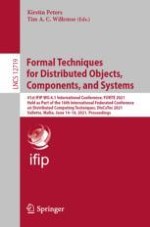This book constitutes the refereed proceedings of the 41st IFIP WG 6.1 International Conference on Formal Techniques for Distributed Objects, Components, and Systems, FORTE 2021, held in Valletta, Malta, in June 2021, as part of the 16th International Federated Conference on Distributed Computing Techniques, DisCoTec 2021.
The 9 regular papers and 4 short papers presented were carefully reviewed and selected from 26 submissions. They cover topics such as: software quality, reliability, availability, and safety; security, privacy, and trust in distributed and/or communicating systems; service-oriented, ubiquitous, and cloud computing systems; component-and model-based design; object technology, modularity, and software adaptation; self-stabilisation and self-healing/organising; and verification, validation, formal analysis, and testing of the above.
Due to the Corona pandemic this event was held virtually.
